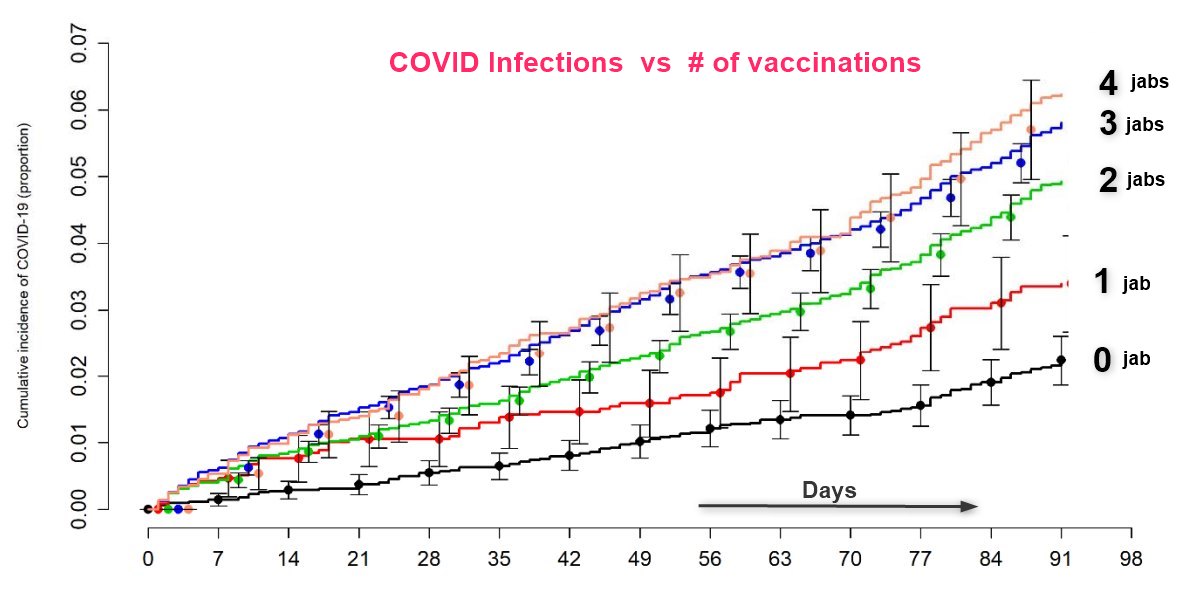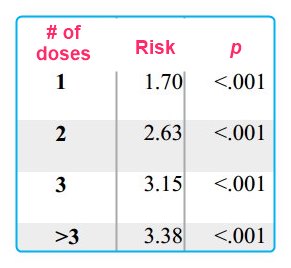More COVID vaccinations, more infections - Cleveland Clinic
Effectiveness of the Coronavirus Disease 2019 (COVID-19) Bivalent Vaccine
medRxiv preprint Dec 19, 2022 [doi: https://doi.org/10.1101/2022.12.17.22283625]
Nabin K. Shrestha,1l [shrestn@ccf.org]; Patrick C. Burke,2 Amy S. Nowacki,3 James F. Simon,4 Amanda Hagen,5 Steven M. Gordon
1 departments of Infectious Diseases, 2Infection Prevention, Quantitative Health Sciences, 4Enterprise Business Intelligence, and Occupational Health, Cleveland Clinic, Cleveland, Ohio, USA.


Summary: Among 51011 working-aged Cleveland Clinic employees, the bivalent COVID-19 vaccine booster was 30% effective in preventing infection , during the time when the virus strains dominant in the community were represented in the vaccine.
Background. The purpose of this study was to evaluate whether a bivalent COVID-19 vaccine protects against COVID-19.
Methods. Employees of Cleveland Clinic in employment on the day the bivalent COVID-19 vaccine first became available to employees, were included. The cumulative incidence of COVID-19 was examined over the following weeks. Protection provided by vaccination (analyzed as a time-dependent covariate) was evaluated using Cox proportional hazards regression. The analysis was adjusted for the pandemic phase when the last prior COVID-19 episode occurred, and the number of prior vaccine doses received.
Results. Among 51011 employees , 20689 (41%) had had a previous documented episode of COVID-19, and 42064 (83%) had received at least two doses of a COVID-19 vaccine. COVID-19 occurred in 2452 (5%) during the study. Risk of COVID-19 increased with time since the most recent prior COVID-19 episode and with the number of vaccine doses previously received. In multivariable analysis, the bivalent vaccinated state was independently associated with lower risk of COVID-19 (HR, .70; 95% C.I., .61 -.80), leading to an estimated vaccine effectiveness (VE) of 30% (95% CI, 20-39%).
Compared to last exposure to SARS-CoV-2 within 90 days, last exposure 6-9 months previously was associated with twice the risk of COVID-19, and last exposure 9-12 months previously with 3.5 times the risk.
Conclusions. The bivalent COVID-19 vaccine given to working-aged adults afforded modest protection overall against COVID-19, while the virus strains dominant in the community were those represented in the vaccine.
📄 Download the PDF from VitaminDWiki
This preprint was discussed in Dr. Campbell video - Jan 4, 2023
Video was removed by YouTube the next day
: Dr. Campbell asked why this sort of study was not done years ago by the CDC, FDA, etc.
Studies with similar conclusions in VitaminDWiki
COVID variants in US evade bivalent vaccination by 3X to 13X – Cell Dec 13, 2022
The more COVID vaccinations you get, the More Likely you’ll get COVID - Oct 2022
6X increase in excess deaths of children since vaccinations were started - Oct 2022
Regional Excess Deaths strongly associated with COVID vaccination rate (UK) – Sept 2022
Pandemic of the Boosted: UK Data Reveal Problem With COVID Vaccinations - July 2022
